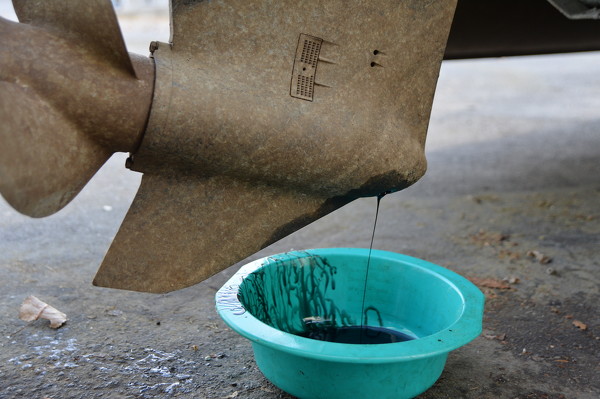Saturday, October 22nd, 2022
Boat owners prepare for the cold
By Bob Tomaszewski

Photo by Paige Sutter/The Daily Standard
Kozy Marina employee Nate Kline of Van Wert begins to extract oil from the lower unit of a engine, the most crucial step to winterizing a boat.
CELINA - As November looms around the corner and temperatures continue to cool, area boat owners are preparing to winterize their boats for the season.
Rob Merrell, manager at Kozy Marina, said the shop is in the full swing of getting Grand Lake's boats ready for the winter.
"We are probably 40 boats deep in it that we are waiting to get winterized," Merrell said.
The manager said their rush depends on the season.
"If it's warm out people obviously want to be out there on their boats as long as possible," Merrell said. "This year it just kind of turned on us all at once."
One of the biggest differences between winterizing a car and winterizing a boat is preventing ice buildup in the engine, Merrell said.
"Your car is going to start up and warm up and a boat is just sitting idle in the elements. It never really does get a chance to warm up until spring," Merrell said. "The real important thing is to make sure you get all the water out of the engine. That's what's going to freeze and expand."
In fall everyone is storing their boats, and in the spring everyone wants boats back in the water, he said. Both are busy times for shops.

Photo by Paige Sutter/The Daily Standard
Oil drains from the lower unit of a engine.
Making sure a boat's oil is drained is an essential step to winterizing a boat, but also one of the slowest, Merrell said.
"That oil thickens up and it runs out of there like honey," Merrell said. "The lower unit is where all the water gets sucked in, that's the important part to drain because if you don't have a good seal then you are going to have water mixed in with your gear oil and it's going to freeze. There is not a whole lot of room in there and when things expand, things break."
Replacing engine parts could cost a boat owner between $2,500 to $3,000 before labor costs, he noted.
Boat owners waiting to winterize may need to use the lake to their advantage, Merrell said. Keeping the boat's engine submerged in water can prevent it from freezing.
"As the temperature starts to drop and you get down closer to 32 degrees where its going to frost out there, obviously the lake is not going to freeze," he said. "So when it gets cold it is probably best to lower your engine into the water so that the lower unit is submerged and kind of insulated under the water. That's going to keep anything from freezing in there."
However, if boaters are done for the season, Merrell said it's time to bring boats ashore. As temperatures continue to drop, Merrell said the rush for winterization rises and owners could be left waiting a substantial amount of time to have their boat winterized.

Photo by Paige Sutter/The Daily Standard
Multiple boats sit ashore at the Kozy Marina on State Route 703.
"If you know you are done for the season you should get it out of there," he said. "If you are waiting you are going to get stuck in the middle of the congestion."
Other recommended steps include stabilizing the fuel to remove moisture, draining the vapor separator or carburetor, greasing exposed fittings and spraying the engine with a protective lube if applicable.
"A lot of customers will want the battery removed so they can take it home and put it on a trickle charger," Merrell said.
However, once spring arrives Kozy Marina employees will undo all their hard work from the previous season to prepare boats for the water once again.
"In the spring we just kind of do the reverse, hook the battery up, get it in the water and get it started," he said.
Merrell said they also recheck fluids and look for potential leaks. Often it can take as much as an hour to remove all the shrink wrap used in storing boats outside during the winter and start boats back up, he said.




